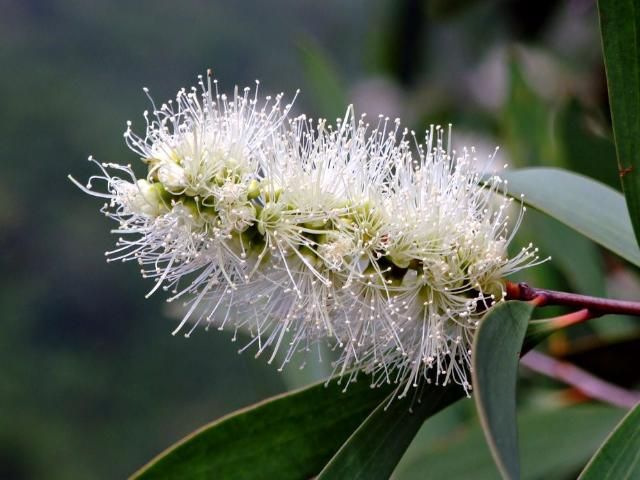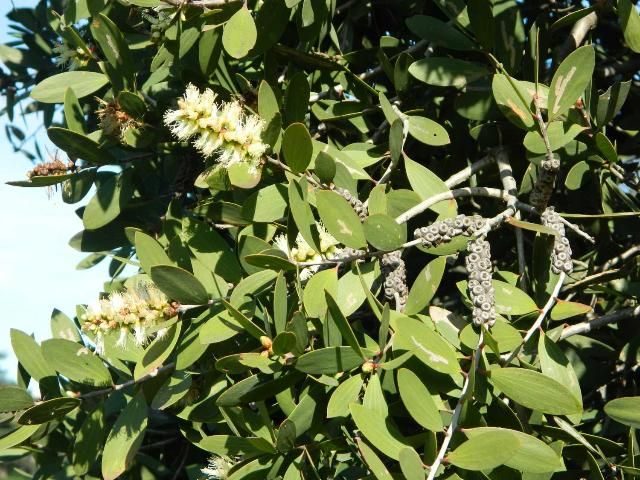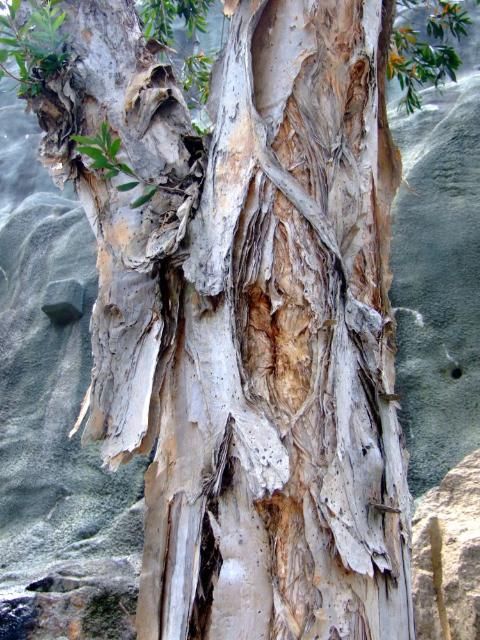Family
Myrtaceae, myrtle family.
Genus
Melaleuca is a combination of two Greek words: melas ("black") and leukos ("white"), in reference to the contrasting black trunk and young white stems or branches that are characteristic of many species in this genus.
Species
The species name, quinquenervia, is based on the tree's five-veined leaves (which are sometimes seven-veined), and is a combination of the Latin words quinqu meaning "five" and nervus meaning "nerve or tendon."
Common Name
Cajeput, Melaleuca, Paperbark Tea Tree, Punktree, White Bottlebrush Tree
One of the common names for this tree, "cajeput," is a combination of two Malaysian words, one meaning "tree" and one meaning "white," in reference to the distinctive white bark of the tree. The name "paperbark" comes from this tree's paper thin, peeling bark. Melaleuca is sometimes called "tea tree" because it resembles Melaleuca alternifolia, the species from which tea tree oil is made. Melaleuca earned the name "punktree" through its ability to persist in habitats where efforts were being put forth to eradicate it. Some people call melaleuca "white bottlebrush tree" because its white flowers look like bottle brushes.
Description
This evergreen tree originates from the South Pacific where it is native to Australia, New Guinea, and the Solomon Islands. In the United States it is non-native and invasive and is found in Louisiana and south of central Florida, where it invades a variety of habitat types ranging from wet swamps to dry uplands. Melaleuca grows well in partial shade and can reach heights of up to 100 feet. Leaves are simple and alternate, and can grow to lengths of 4 inches. The grayish green leaves have a narrow lanceolate shape, entire margins, and 5 to 7 parallel veins that run from the tip of the leaf blade down to its base. When the leaves are crushed they release an aroma similar to camphor. The outer bark is whitish and soft, and peels into thin layers, revealing a reddish inner bark. During the spring and summer months, fragrant white flowers bloom in clusters shaped like bottle brushes. Fruits are small (3/8 inch), woody, cylindrical capsules borne in clusters on young branchlets, and each capsule houses between 200 to 300 tiny seeds.

Credit: kaiyanwong223, CC BY-NC-SA 2.0

Credit: lookscloser, CC BY-NC-SA 2.0

Credit: kaiyanwong223, CC BY-NC-SA 2.0
Allergen
When in bloom, melaleuca can emit a strong odor and release oils into the air that can cause allergy-like symptoms such as headaches, respiratory problems, and skin rashes. Overall, this tree is considered highly allergenic.
Storm Tolerance
Melaleuca has low wind resistance.
Applications
Commercial/Practical
Florida's apiary industry makes use of this nuisance tree by harvesting honey crops made by bees pollinating the bottlebrush flowers it produces. However, many Floridians feel that this economic benefit is overshadowed by the tree's environmental threats, including displacement of native vegetation leading to loss of critical wildlife habitat. In an attempt to control this tree's spread, some companies cut them down and process them into mulch, which many local garden centers carry. This mulch is considered "safe" to use because it is treated with high heat in order to prevent any remnant seeds from germinating.
Horticultural
In the early 1900s, this tree was introduced into Florida as an ornamental plant. In the 1930s it was intentionally spread throughout the Everglades area and subsequently began changing the dynamics of this unique ecosystem. It was even planted as a landscape tree in Florida yards until the late 1970s. Today this tree is recognized as a Category I noxious weed by the Florida Invasive Species Council and is prohibited from being planted in Florida.
References
Borror, D. J. 1988. Dictionary of root words and combining forms. Mountain View, CA: Mayfield Publishing Company.
Burns, R. M., B. H. Honkala, and Coordinators 1990. Silvics of North America: Volume 2. hardwoods. Retrieved. from https://www.srs.fs.usda.gov/pubs/misc/ag_654_vol2.pdf
Center for Aquatic and Invasive Plants. 2009. Melaleuca quinquenervia. Retrieved from https://plants.ifas.ufl.edu/media/plantsifasufledu/homepage/resources/management-guides/10_Melaleuca_ADA.pdf
Coombes, A. 1994. Dictionary of plant names: Botanical names and their common name equivalents. Portland, OR: Timber Press.
Duryea, M. and E. Kampf. 2007. Selecting tropical and subtropical tree species for wind resistance (FOR120). Gainesville, FL: UF-IFAS Florida Cooperative Extension Service. Retrieved from https://edis.ifas.ufl.edu/publication/fr175
Florida Invasive Species Council. 2019. 2019 FLEPPC List of Invasive Plant Species. Retrieved from https://www.floridainvasives.org/plant-list/
Gilman, E. F. 1997. Trees for urban and suburban landscapes. Albany, NY: Delmar Publishers.
Langeland, K. A. and K. C. Burks, Eds. 1998. Identification and biology of non-native plants in Florida's natural areas. Gainesville, FL: University of Florida.
Nelson, G. 1994. The trees of Florida: A reference and field guide. Sarasota, FL: Pineapple Press.
Ogren, T. L. 2000. Allergy-free gardening: The revolutionary guide to healthy landscaping. Berkeley, CA: Ten Speed Press.
Osorio, R. 2001. A gardener's guide to Florida's native plants. Gainesville, FL: University Press of Florida.
USDA Natural Resources Conservation Service. (n.d.). PLANTS Database. Retrieved from https://plants.usda.gov/home